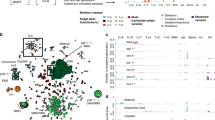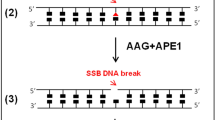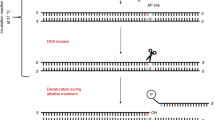Abstract
PERHAPS the most successful screening test to detect potential mutagens and/or carcinogens is that of Ames et al.1, using Salmonella. Attempts to use mammalian cells have generally involved measuring some cellular response to DNA damage, for example, induction of DNA repair2; if the response implies that an agent has damaged the DNA, the agent is considered to be a potential mutagen and/or carcinogen. An early response to DNA damage in human cells is inhibition of DNA synthesis. But certain non-DNA-damaging agents also inhibit DNA synthesis. I show here that DNA-damaging and non-DNA-damaging agents can be distinguished by the changes in the rates of DNA synthesis after treatment: with a DNA-damaging agent, the rate of DNA synthesis continues to decrease, but with a non-DNA-damaging agent the rate of DNA synthesis increases after treatment.
This is a preview of subscription content, access via your institution
Access options
Subscribe to this journal
Receive 51 print issues and online access
$199.00 per year
only $3.90 per issue
Buy this article
- Purchase on Springer Link
- Instant access to full article PDF
Prices may be subject to local taxes which are calculated during checkout
Similar content being viewed by others
References
Ames, B. N., Durston, W. E., Yamasaki, E. & Lee, F. D. Proc. natn. Acad. Sci. U.S.A. 70, 2281–2285 (1973).
San, R. H. C. & Stich, H. F. Int. J. Cancer 16, 284–291 (1975).
Ames, B. N., McCann, J. & Yamasaki, E. Mutat. Res. 31, 347–364 (1975).
Cleaver, J. E. & Thomas, G. H. Biochem. biophys. Res. Commun. 36, 203–208 (1969).
Lehmann, A. R. J. molec. Biol. 66, 319–337 (1972).
Makino, F. & Okada, S. Radiat. Res. 62, 37–51 (1975).
Walters, R. A. & Hildebrand, C. E. Biochem. biophys. Res. Commun. 65, 265–271 (1975).
Painter, R. B. & Young, B. R. Radiat. Res. 64, 648–656 (1975).
Painter, R. B. Mutat. Res. (in the press).
Painter, R. B. & Young, B. R. Biochim. biophys. Acta 418, 146–153 (1976).
Furst, A. & Haro, R. T. in Physico-Chemical Mechanics of Carcinogenesis (ed. Bergmann, E. D. & Pullman, B.), 310–320 (Israel Academy of Sciences and Humanities, Jerusalem, 1969).
Gautschi, J. R. & Kern, R. M. Expl Cell Res. 80, 15–26 (1973).
Gautschi, J. R., Kern, R. M. & Painter, R. B. J. molec. Biol. 80, 393–403 (1973).
Author information
Authors and Affiliations
Rights and permissions
About this article
Cite this article
PAINTER, R. Rapid test to detect agents that damage human DNA. Nature 265, 650–651 (1977). https://doi.org/10.1038/265650a0
Received:
Accepted:
Issue Date:
DOI: https://doi.org/10.1038/265650a0
This article is cited by
-
Evaluation of mutagenic and cytotoxic effects of sodium fluoride on mammalian cells influenced by an acid environment
Cell Biology and Toxicology (1996)
-
Application of the cell growth and DNA-inhibition tests for characterizing sulfate pulp mill waste waters
Folia Microbiologica (1993)
-
Effect of the insecticide actellic on soil microorganisms and their activity
Folia Microbiologica (1992)
-
Mode of action of C-1027, a new macromolecular antitumor antibiotic with highly potent cytotoxicity, on human hepatoma BEL-7402 cells
Cancer Chemotherapy and Pharmacology (1990)
Comments
By submitting a comment you agree to abide by our Terms and Community Guidelines. If you find something abusive or that does not comply with our terms or guidelines please flag it as inappropriate.



